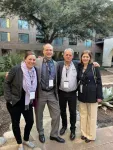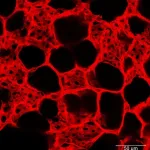(Press-News.org) Most women agree that menopause has its advantages and disadvantages. Some relish the end of menstruation and concerns about unplanned pregnancies, while others dread the possibililty of hot flashes, moodiness, and other unpleasant symptoms. What some women consider a brief and barely noticeable phase in their lives can evolve into lasting changes and discomfort for others.
Now, a new paradigm around the biological processes of menopause is capturing the attention of a small group of scientists around the country. The primary question: can menopause be delayed in healthy women, allowing them to extend their child-bearing years—and perhaps even forestall some of the health risks and uncomfortable symptoms linked to plummeting estrogen levels? These questions can be controversial: Some people believe that such research could lead to life-changing benefits for women, while others consider menopause to be a biologically driven life stage that should not be pathologized by medical science.
At Yale School of Medicine (YSM), Kutluk Oktay, MD, PhD, an ovarian biologist who is director of the Laboratory of Molecular Reproduction and Fertility Preservation, recently added a new chapter to this conversation by publishing research on various possible outcomes when menopause is delayed in healthy women via ovarian tissue freezing.
Oktay, who developed and performed the world’s first ovarian transplant procedure with cryopreserved tissue for a patient with a medical indication in 1999, sees a future in which healthy women could use this process of freezing tens of thousands of eggs within the ovarian tissue to stave off menopause for as long as several decades—or even prevent its onset altogether.
“For the first time in medical history, we have the ability to potentially delay or eliminate menopause,” said Oktay, who is also an adjunct professor of obstetrics, gynecology & reproductive sciences at YSM.
A mathematical model predicts outcomes for delayed menopause
Using data from hundreds of previous ovarian cryopreservation and transplantation procedures, and molecular studies of how ovarian follicles behave in ovarian tissue, Oktay and his colleagues built a new mathematical model, published in the American Journal of Obstetrics & Gynecology, to predict how long the surgery could potentially delay menopause under a range of circumstances in healthy women.
Since Oktay performed the first successful transplantation with cryopreserved tissue, ovarian tissue cryopreservation has been successfully used in cancer patients to preserve their fertility before their treatments, which can often permanently damage the egg reserve in the ovaries and trigger menopause. During this outpatient procedure, a surgeon laparoscopically removes the whole ovary or layers of the outer portion, which contains hundreds of thousands of dormant, immature eggs (known as primordial follicles).
These tissues are then stored in sealed containers after being frozen with a specialized process and kept as low as negative 320 degrees Fahrenheit. Freezing ovarian tissue with this specialized process preserves it for later use. At some point—typically years—in the future, the surgeon reimplants the thawed tissue into the patient either laparoscopically or with a simple procedure, using methods developed by Oktay, that places the tissue under the patient’s skin while intravenous sedation is administered. Within three to 10 days after that, this transplanted tissue regains connections with the surrounding blood vessels and restores ovarian function in about three months.
The recently published mathematical model focusing on healthy women undergoing ovarian tissue cryopreservation considers multiple factors, including the age at which a patient gets the procedure, which plays a significant role in how long menopause can potentially be delayed.
“The younger the person, the larger number of eggs she has, as well as the higher the quality of those eggs,” Oktay said. The model accounts for women between the ages of 21 and 40. Beyond age 40, data show that the procedure is unlikely to delay menopause for a woman with average egg reserve, but this can change with the development of more efficient freezing and transplantation methods in the future.
Furthermore, the model offers insight into the ideal amount of ovarian tissue to collect. The more tissue a surgeon removes, the longer the procedure can potentially delay menopause. However, the removal of too much tissue can lead to early menopause. “This model gives us the optimum amount of tissue to harvest for a person of a given age,” said Oktay.
The model also takes into account the healing process after a surgeon returns the harvested ovarian tissue to the patient. During this healing process, some of the primordial follicles are lost. Studies on animal models show that as many as 60% of primordial follicles do not survive post-transplantation, leaving 40% that are viable. With newer technologies, Oktay said that he believes surgeons can attain a survival rate of up to 80%. As the procedure continues to improve, he hopes to eventually achieve a 100% survival rate. Thus, the model accounts for survival rates ranging from 40% to 100%.
Additionally, through transplanting portions of the harvested tissues over several procedures, the research indicates that menopause can be delayed even longer. For example, the team’s model shows that returning a third of the outer portion of the ovary over each of three procedures delayed menopause longer than returning all of the tissue through one surgery.
Based on the model, Oktay predicts that for most women under 40, ovarian cryopreservation can significantly delay menopause. And for women under 30, the procedure may be able to prevent menopause altogether.
Because many women lose their ability to become pregnant sooner than they desire, ovarian cryopreservation could be an appealing option for them, said Hugh S. Taylor, MD, chair and Anita O’Keeffe Young Professor of Obstetrics, Gynecology & Reproductive Sciences at YSM. “Women are also frequently deferring pregnancy until later in life for professional or social reasons,” he added. “The ability to freeze and later transplant ovarian tissue…offers a way to extend their fertile lifespan.”
Does delaying menopause via cryopreservation offer health benefits?
Delaying menopause with ovarian cryopreservation also may confer certain health benefits associated with a later menopausal age. Based on new research by Oktay and his colleagues, around 11% of women experience late-onset natural menopause—or menopause after age 55. Studies show that women who experience menopause later may live longer and have a lower risk for a range of conditions, including cardiovascular disease, dementia, retinal disease, depression, and bone loss. However, uncertainty remains over whether later menopause actually reduces those health risks. Oktay hypothesizes that those risks also may be mitigated in healthy women who delay menopause via ovarian tissue cryopreservation.
If risk for such chronic diseases is reduced in healthy women who undergo this procedure, it could be a significant benefit. However, Taylor said that “additional research is needed to determine long-term benefits as well as risks.”
In ongoing research, Oktay and his team are studying the outcomes of healthy women who have opted to delay menopause through this procedure. Publication of these studies is far in the future, but in the meantime, the mathematical model offers a starting point for considering the feasibility and possible benefits of forestalling menopause in healthy women.
The study was co-authored by Joshua Johnson, PhD, of the University of Colorado School of Medicine; Sean D. Lawley, PhD, of the University of Utah; and John W. Emerson, PhD, of Yale University.
END
How ovarian tissue freezing could prevent menopause—possibly forever
2024-02-06
ELSE PRESS RELEASES FROM THIS DATE:
Chemists decipher reaction process that could improve lithium-sulfur batteries
2024-02-06
Key takeaways
Lithium-sulfur batteries have the potential to transform energy storage, with exceptional theoretical capacity and performance in combination with an element in abundant supply. But the intricate reaction mechanism, particularly during discharge, has been challenging to solve.
UCLA researchers have identified the key pathways to a complex sulfur reduction reaction that leads to energy loss and reduced battery life span.
The study’s findings establish the whole reaction network for the first ...
UTEP researchers win inaugural award to support lithium extraction technology
2024-02-06
EL PASO, Texas (Feb. 6, 2024) – A group of researchers at The University of Texas at El Paso are behind an emerging lithium extraction technology that won the inaugural Hill Prize from the Texas Academies of Medicine, Engineering, Science and Technology (TAMEST) on Monday. The $500,000 in prize funds will support a joint research effort by Alma Energy and UTEP to extract lithium from hydrothermal waters.
“If this technology succeeds, it would be a really massive breakthrough in environmentally-friendly lithium extraction,” said Benjamin Brunner, Ph.D., the co-inventor of the technology ...
Complex tree canopies help forests recover from moderate-severity disturbances
2024-02-06
WEST LAFAYETTE, Ind. — Extreme events wipe out entire forests, dramatically eliminating complex ecosystems as well as local communities.
Researchers have become quite familiar with such attention-grabbing events over the years. They know less, however, about the more common moderate-severity disturbances, such as relatively small fires, ice storms, and outbreaks of pests or pathogens.
“Since they’re more common, they’re probably playing a larger role in the ecosystem than we might have appreciated before,” said Brady Hardiman, associate professor of forestry and natural resources and environmental ...
Flu virus variants resistant to new antiviral drug candidate lose pathogenicity, study finds
2024-02-06
ATLANTA — Influenza A viruses with induced resistance to a new candidate antiviral drug were found to be impaired in cell culture and weakened in animals, according to a study by researchers in the Center for Translational Antiviral Research at Georgia State University.
In a study published in PLoS Pathogens, the authors explored the developmental potential of 4’-fluorouridine (4’-FlU), a clinical drug candidate, for influenza therapy. They resistance profiled the compound against influenza viruses and mapped possible routes of viral escape, addressing specifically ...
Microfluidic environments alter microbe behaviors, opening potential for engineering social evolution
2024-02-06
Microbes are social beings.
Much like humans, they communicate and cooperate with each other to solve problems bigger than themselves. In a microbial community, there will even be free riders, and others that police them.
So, what if researchers could influence their social evolution to promote certain behaviors? Doing so can be vital to solving many of today’s challenges such as combating infection and antibiotic resistance, developing microbial strategies for wastewater treatment or harvesting alternative energy sources.
A research group led by Dervis Can Vural, an associate professor in the Department of Physics and Astronomy at ...
Structural isomerization of individual molecules using a scanning tunneling microscope probe
2024-02-06
1. An international research team led by NIMS, the Osaka University Graduate School of Science and the Kanazawa University Nano Life Science Institute (WPI-NanoLSI) has succeeded for the first time in controlling the chirality of individual molecules through structural isomerization. The team also succeeded in synthesizing highly reactive diradicals with two unpaired electrons. These achievements were made using a scanning tunneling microscope probe at low temperatures.
2. It is usually quite challenging to control the chirality of individual molecular units and synthesize extremely reactive diradicals in organic chemistry, preventing ...
Moffitt study suggests improvements needed for patient-reported outcome data in genitourinary cancer clinical studies
2024-02-06
TAMPA, Fla. — Patient-reported outcomes are important indicators of how cancer drugs impact patients’ lives. By assessing the benefits and risks of drugs from a patient’s perspective, scientists and physicians can improve the development of patient-centered drugs and care. In a recent study published in eClinicalMedicine, part of The Lancet Discovery Science, Moffitt Cancer Center researchers demonstrate that there is a significant unmet need for improved analyses and reporting of patient-reported outcomes in genitourinary cancer clinical trials.
Health care professionals have realized that how a disease and its treatment ...
New EU-funded project "FOOD includes" aims to improve the inclusiveness and accessibility of adult education
2024-02-06
In December 2023, the new "FOOD includes" project funded by the European Commission started at the Center for Lifelong Learning at Johannes Gutenberg University Mainz (JGU). Over its 36-month term, the objective of "FOOD includes" is to increase take-up and improve the inclusiveness and accessibility of adult education. The project has been designed for adults with lower academic qualifications and migrants who are less likely to take advantage of continuing education and training opportunities. Therefore, the project focuses on activities revolving ...
New water-focused innovation engine aims to turn waste into wealth for Great Lakes region
2024-02-06
The waste in our water could soon generate new waves of clean energy development, job creation and economic growth across the Great Lakes thanks to a new regional innovation and economic development initiative launched by the U.S. National Science Foundation (NSF). The initiative will fund efforts to find new ways to recover clean water, nutrients and materials for clean energy technologies from wastewater — all while removing dangerous chemicals.
These efforts will be carried out by Great Lakes ReNEW, a collaboration of research institutions, universities, ...
Researchers breathe new life into lung repair
2024-02-06
In the human body, the lungs and their vasculature can be likened to a building with an intricate plumbing system. The lungs’ blood vessels are the pipes essential for transporting blood and nutrients for oxygen delivery and carbon dioxide removal. Much like how pipes can get rusty or clogged, disrupting normal water flow, damage from respiratory viruses, like SARS-CoV-2 or influenza, can interfere with this “plumbing system.”
In a recent study, researchers looked at the critical role of vascular ...




